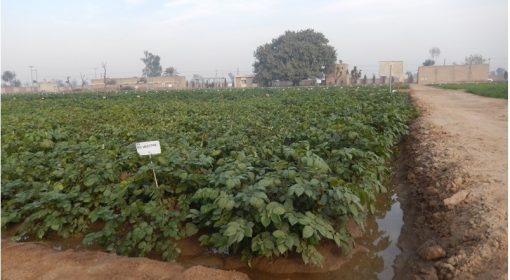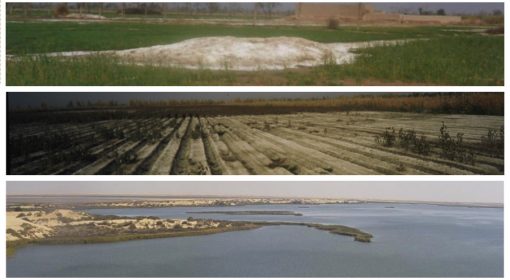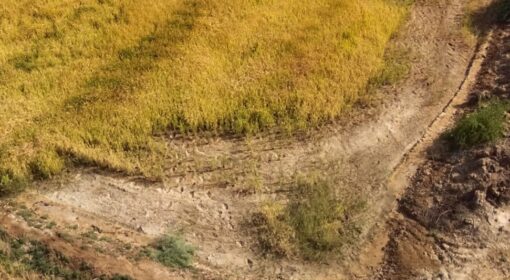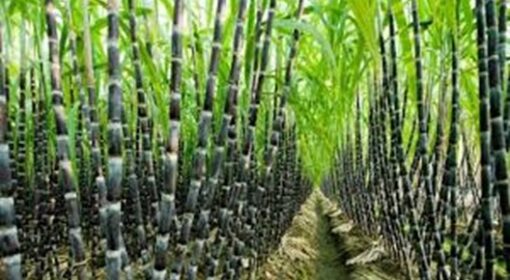This blog is part of a series developed in the context of the ISSM4RICE project (see link: Tackling soil salinity in rice-based systems – TheWaterChannel
Authors: Clara Nieuwenhuyse, Ali Ibrahim, Eric Kabore, Frank Croon
Increased salinity levels in soils affect, or make impossible, the growth of most crops. Soil salinity is caused by an accumulation of salts in the (upper) layers of the soil. The salts originate from irrigation water, plus, in most cases, the capillary rises from shallow groundwater. The irrigation and possibly also the groundwater evaporates from the soil and/or is evapotranspirated by the crop, leaving the salts accumulating over time. All-natural water used for irrigation contains some salts. Consequently, if salts are not removed or leached from the soil, either by applying extra irrigation water or rainwater, they will accumulate over the years, and the soil will gradually become more saline.
Salinity levels in the soils can be maintained at acceptable levels, which are crop-specific. Therefore, a salt balance must be maintained, meaning that on an annual basis the limited amounts of salts that flow into a field are leached out. This can be done by leaching the soil with extra irrigation water complemented by rainwater that flows out through a natural or artificial drainage system. At the field level, avoiding salinization from the shallow groundwater is practically impossible since this would require lowering the groundwater table to levels between 2 to 3 m below field level.
In Senegal, the main value chains affected by salinization are rice, sorghum, and millet production, as well as vegetable gardening (Sene, 2023). It is estimated that 1.7 million hectares are affected, representing 45% of arable lands over the country (National Institute of Pedology, 2008). The impact of soil salinization on the local population is multiple: damaged arable lands are abandoned, and an increased shortage of suitable arable land happens as the population increases. The migration of younger populations towards urban centers for new economic opportunities is also an important consequence.
As soil salinization is influenced by a diverse range of factors, one can wonder where to start. The following blog provides an overview of important points to consider for a water management approach to soil salinity management.
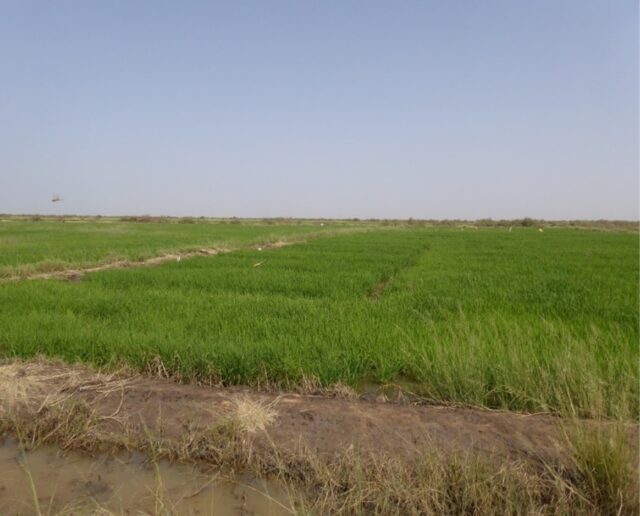
Water management to maintain a salt-water balance
Water management practices are closely linked to salinization rates. Irrigation methods that apply large amounts of water, such as flood irrigation, can raise the water table if there is inadequate drainage. When the water table rises, salts from deeper layers of soil can be brought up to the root zone through capillary action, leading to salinization. In addition, flood irrigation leads to uneven water distribution in the field. Waterlogging due to an unproper drainage leads to salt accumulation at the surface, when water evaporates and contributes to the build-up of salt content at the soil surface (Paz et al., 2020). This emphasizes the use of suitable irrigation techniques coupled with proper field drainage.
Irrigations techniques suitable for systems facing increased salinization hence imply lower water consumption and optimization of watering schedules. As over-optimal irrigation can exacerbate the salinization issue, drip-irrigation provides a lower and continuous water supply to the plant. Research conducted by Dong et al. (2022) and Wang et al. (2023) found that the latest can then lead to greater water savings and salt suppression.
Flushing, or conducting leaching from the soil with freshwater to remove salts from the surface of the soil is another technique. The excessive salt accumulation in the rootzone can be avoided by applying extra water of that of the crops requirements over the long term. An amount of water exceeding the crop needs is applied during the growing season, so that the water in excess moves part of the salts deeper than the root zone by deep percolation. This amount is known as the leaching requirements or LR, the portion of infiltrated water that needs to pass through the rootzone to keep salinity within acceptable levels (Bello et al., 2021). This leaching fraction, expressed in percentage. For successful application of flushing methods, drainage needs to be ensured at sufficient depth . A major limitation of flushing is that this solution is not adequate in places that face water scarcity and is time-costly (Bello et al., 2021).
Drainage can mitigate Salinization effects with the removal of excessive water plus salt from the fields. However, meanwhile salt can accumulate in the rootzone when drainage is conducted on an insufficient basis, high drainage removing the water from the upper soil layers can lead to the rise of saline water stored in the deeper soil layers, hence leading to a greater salinization. The Ground Water table level must be maintained to a level that permits adequate root development while avoiding the rise of salt-loaded groundwater to the upper soil levels by capillarity (Rhoadles et al., 1992).
Note: Leaching and drainage of the soils are also related to the leaching of nutrients (e.g. nitrates). Measures to restore soil fertility might be necessary to take simultaneously (Paz et al., 2020).
Adjusting irrigation scheduling. According to Paz et al. (2020), surface irrigation can help eliminate the build-up of salinity in the root zone and ensure optimal crop production conditions when conducted in a reduced number of irrigation events. This is because small irrigation intervals favor the water uptake from the upper soil layers, which in turns increases evaporation losses from the soil surface and lead to increased salt concentration. However, large irrigation intervals can also lead to salinization: as the water content of the soil dries, salt is transported upwards in the soil from the deeper layers or from saline groundwater by capillarity (Rhoadles et al., 1992).
Use of multi-salinity waters. In case freshwater supplies are not sufficient to meet crops requirements, slightly saline waters can be used either separately from the freshwater resources, in a cyclic way, or combined with freshwater. In a cyclic irrigation strategy, freshwater must be applied during germination and seedling stages, which are critical times when the plant is the most sensitive. The application of somehat more saline water would be conducted afterwards, when the plant has higher salinity tolerance levels. When saline water and freshwater sources are blended, the irrigation mix resulting should target a salinity level for the specific crop. Blending water sources requires adequate infrastructure such as a dilution network and storage reservoirs (Paz et al., 2020).
Rainwater harvesting facilities can ensure farm-scale freshwater is available for emergency irrigation, or on a larger scale align with public supply needs. Such facilities would also help reduce groundwater extraction.
Mitigation measures aim to reduce the adverse effects of soil salinization. They rely on the adoption of sustainable water management practices regarding both irrigation methods and water supply, but also adequate crop and soil management.
In conclusion, various water-centered options exist to mitigate soil salinity. Maintaining a proper salt-water balance is crucial to prevent salt accumulation over time. However, a major constraint to the adoption of mitigation practices is the lack of suitable facilities and water-related infrastructures, which are often beyond farmers’ scope of incidence. A salt-water balance for the crops can be established under the present conditions, based on which an irrigation schedule can be formulated in relation to water availability. Surface drainage methods (ditches) at a depth tuned to the crops (root depth) can be proposed. Ensuring access to adequate irrigation and drainage infrastructure is essential, and the integration of adequate water management practices should then be supported by suitable governance frameworks, reflected by the involvement of stakeholders on both technical and political levels. Collaborative efforts and coordinated actions are required to ensure long-term mitigation of soil salinity.
A questionnaire form collecting the necessary data to create a salt-water balance can be downloaded via the following link
- Read more on salinity and soil management: Tackling soil salinity – The role of soil management – TheWaterChannel
- Link to salinity management fascicules (in French): Salinity management in rice fields manuals | MetaMeta – The Difference in Water, Land and People
Resources:
Bello, S. K., Alayafi, A. H., Al-Solaimani, S. G., & Abo-Elyousr, K. A. (2021). Mitigating soil salinity stress with gypsum and bio-organic amendments: A review. Agronomy, 11(9), 1735.
Dong, S., Wang, G., Kang, Y., Ma, Q., & Wan, S. (2022). Soil water and salinity dynamics under the improved drip-irrigation scheduling for ecological restoration in the saline area of Yellow River basin. Agricultural Water Management, 264, 107255.
National Institute of Pedology (2008). Estimation des terres affectées par le processus de salinisation au Sénégal. Rapport annuel. p 38
Paz, Ana ; Hristov, Biser ; Amezketa, Esperanza ; Falsone, Gloria ; Zambujo, Jorge ; Canfora, Loredana ; Mastrorilli, Marcello ; Gonçalves, Maria ; Prins, Pieter ; Ramos, Tiago. (2020). Prevention, mitigation and adaptation strategies for soil salinisation at farm level.
Rhoadles, D., Kandiah, A., & Mashali, A. M. (1992). The use of saline waters for crop production-FAO irrigation and drainage paper 48.
Sene, Jean Henri Bienvenue (2023). Curbing the salinization of arable land and agronomically restoring salt affected soils, a food security challenge: assessment and prospects, the case of Senegal in West Africa. Presentations – INSAS second meeting, Uzbekistan. Presentation available on: https://www.fao.org/global-soil-partnership/insas/insas-second-meeting-presentation/en/
Wang, Y., Gao, M., Chen, H., Fu, X., Wang, L., & Wang, R. (2023). Soil moisture and salinity dynamics of drip irrigation in saline-alkali soil of Yellow River basin. Frontiers in Environmental Science, 11, 1130455.
